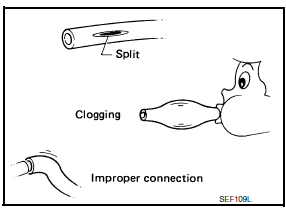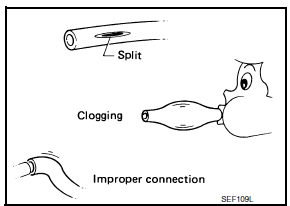Nissan Maxima Service and Repair Manual: Variable induction air system
Description
Power Valves 1 and 2
The power valves 1 and 2 are installed in intake manifold collector and used to
control the suction passage of
the variable induction air control system. They are set in the fully closed or
fully opened position by the power
valve actuators 1 and 2 operated by the vacuum stored in the vacuum tank. The
vacuum to power valve actuators
is controlled by the VIAS control solenoid valves 1 and 2.
Component Function Check
1.CHECK OVERALL FUNCTION-I
With CONSULT
- Start engine and warm it up to the normal operating temperature.
- Perform "VIAS S/V-1" in "ACTIVE TEST" mode with CONSULT.
- Turn VIAS control solenoid valve 1 "ON" and "OFF", and check that power valve actuator 1 rod moves.

- Power valve actuator 1
- Power valve actuator 1 rod
- Power valve actuator 2 rod
- Power valve actuator 2
 : Vehicle front
: Vehicle front
Without CONSULT
- Start engine and warm it up to the normal operating temperature.
- When revving engine up to 5,000 rpm quickly.
- Check that power valve actuator 1 rod moves under the following conditions.

- Power valve actuator 1
- Power valve actuator 1 rod
- Power valve actuator 2 rod
- Power valve actuator 2
 : Vehicle front
: Vehicle front

2.CHECK OVERALL FUNCTION-II
With CONSULT
- Perform "VIAS S/V-2" in "ACTIVE TEST" mode with CONSULT.
- Turn VIAS control solenoid valve 2 "ON" and "OFF", and check that power valve actuator 2 rod moves.

- Power valve actuator 1
- Power valve actuator 1 rod
- Power valve actuator 2 rod
- Power valve actuator 2
 : Vehicle front
: Vehicle front
Without CONSULT
- When revving engine up to 5,000 rpm quickly.
- Check that power valve actuator 2 rod moves under the following conditions.

- Power valve actuator 1
- Power valve actuator 1 rod
- Power valve actuator 2 rod
- Power valve actuator 2
 : Vehicle front
: Vehicle front

Diagnosis Procedure
1.INSPECTION START
Confirm the malfunctioning system (power valve 1 or power valve 2).
2.CHECK VACUUM EXISTENCE-I
With CONSULT
- Stop engine and disconnect vacuum hose connected to power valve actuator 1.
- Start engine and let it idle.
- Perform "VIAS S/V-1" in "ACTIVE TEST" mode with CONSULT.
- Turn VIAS control solenoid valve 1 "ON" and "OFF", and check vacuum existence under the following conditions.

Without CONSULT
- Stop engine and disconnect vacuum hose connected to power valve actuator 1.
- Disconnect VIAS control solenoid valve 1 harness connector.
- Start engine.
- When revving engine up to 5,000 rpm quickly.
- Check vacuum existence under the following conditions.

3.CHECK VACUUM TANK
- Stop engine and disconnect vacuum hose connected to intake manifold collector.
- Start engine and let it idle.
- Check vacuum existence from intake manifold collector.
4.CHECK VACUUM HOSE
- Stop engine.
- Check vacuum hose for cracks, clogging, improper connection or disconnection.

5.CHECK VIAS CONTROL SOLENOID VALVE 1
6.CHECK VACUUM EXISTENCE-II
With CONSULT
- Stop engine and disconnect vacuum hose connected to power valve actuator 2.
- Start engine and let it idle.
- Perform "VIAS S/V-2" in "ACTIVE TEST" mode with CONSULT.
- Turn VIAS control solenoid valve 2 "ON" and "OFF", and check vacuum existence under the following conditions.

Without CONSULT
- Stop engine and disconnect vacuum hose connected to power valve actuator 2.
- Disconnect VIAS control solenoid valve 1 harness connector.
- Start engine.
- When revving engine up to 5,000 rpm quickly.
- Check vacuum existence under the following conditions.

7.CHECK VACUUM HOSE
- Stop engine.
- Check vacuum hose for cracks, clogging, improper connection or disconnection.

8.CHECK VIAS CONTROL SOLENOID VALVE 2
9.CHECK INTERMITTENT INCIDENT
 Refrigerant pressure sensor
Refrigerant pressure sensor
Description
The refrigerant pressure sensor is installed at the condenser of the air
conditioner system. The sensor uses an
electrostatic volume pressure transducer to convert refrigerant pressur ...
 ECU diagnosis information
ECU diagnosis information
ECM
Reference Value
VALUES ON THE DIAGNOSIS TOOL
NOTE:
The following table includes information (items) inapplicable
to this vehicle. For information (items) applicable
to this vehi ...
Other materials:
Releasing the trunk lid
Press the button for longer than
1 second
to open the trunk lid. The trunk release button will
not operate when the ignition switch is in the ON
position or when the trunk cancel switch is in the
OFF position. For additional information, refer to
"Cancel switch" in this section. ...
Road wheel tire assembly
Adjustment
BALANCING WHEELS (ADHESIVE WEIGHT TYPE)
Preparation Before Adjustment Remove inner and outer balance weights from
the road wheel. Using releasing agent, remove double-faced adhesive tape from
the road wheel.
CAUTION:
Be careful not to scratch the road wheel during removal ...
Front door speaker
Description
The audio unit sends audio signals to the BOSE speaker amp. The BOSE speaker
amp. amplifies the audio signals before sending them to the front door
speakers using the audio signal circuits.
Diagnosis Procedure
1.CONNECTOR CHECK
Check the audio unit, BOSE speaker amp. and speaker ...
Nissan Maxima Owners Manual
- Illustrated table of contents
- Safety-Seats, seat belts and supplemental restraint system
- Instruments and controls
- Pre-driving checks and adjustments
- Monitor, climate, audio, phone and voice recognition systems
- Starting and driving
- In case of emergency
- Appearance and care
- Do-it-yourself
- Maintenance and schedules
- Technical and consumer information
Nissan Maxima Service and Repair Manual
0.0054
